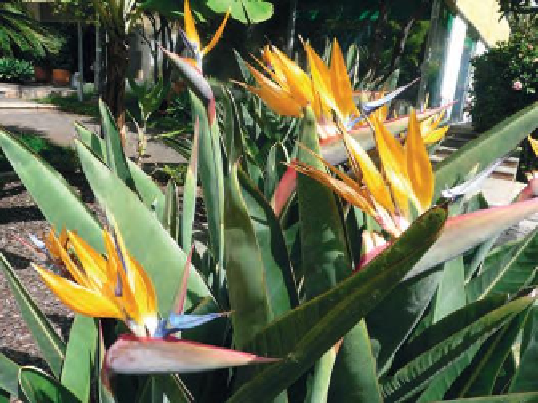Agriculture Reference
In-Depth Information
2
(a)
(b)
Figure 2.3
(a) Antirrhinums originate from the Mediterranean area; (b)
Strelitzia reginae
originates from southern
Africa
point
for that genus. For example, the genus
Fuchsia
has most of its species in the tropical part of the South
American Centre, indicating that this genus probably
originated in this area.
Second, the 'centre of origin' of plant cultivars is often
seen as an indication that a community of people have
shown the interest and ability to select and develop
improved plant varieties
and cultivars from a wild
ancestor species. For example, the wide range of
tomato cultivars seen in the Andes/Central America/
Mexico area was developed from wild
Solanum
species by the Mayans, Aztecs and Incas.
Important examples of plant resistance against tomato
diseases has recently been identified from different
wild South American
Solanum
species:
X
tomato mosaic virus resistance from
Solanum
chilense
(from Peru and Chile)
X
corky root disease resistance from
Solanum
corneliomuelleri
(from Peru)
X
Fusarium
wilt resistance from
Solanum
habrochaites
(from Ecuador and Peru)
X
Alternaria
leaf spot and
Cladosporium
leaf spot
resistance from
Solanum peruvianum
(from Peru).
Below, twelve important '
centres of origin
'
distributed around the world are briefly described.
Emphasis is given here to the
geographical
position
of the area. On page 19, a review of
climatic
aspects
of plant distribution is given.
1. The
Mediterranean
Centre and surrounding
areas have given rise to more than 1,000 ornamental
species (about 20% of the total of common garden
plants in cultivation). Popular commercial plants
in Britain and Ireland native to the Mediterranean
Centre include: antirrhinum, daffodil (
Narcissus
hybida
), hyacinth (
Hyacinths hybrid
),
Cyclamen
, stock
(
Matthiola incana
), iris (
Iris hybrida
), some carnations
(
Dianthus
), garden pansy (
Viola x wittrockiana
), horse
chestnut (
Aesculus hippocastanum
), hyacinth, laurel
(
Laurus nobilis
), oleander (
Nerium oleander
), lily (
Lilium
candidum
), fig (
Ficus carica
), cornflower (
Centaurea
),
poppies (
Papaver
) and Christmas rose (
Helleborus
niger
).
Edible
plants originating from this region include
asparagus, beetroot, Brussels sprouts, cabbage,
cauliflower, celery, fennel, grape, lettuce, onion,
parsnip, rhubarb, rosemary and wheat.
2. The
African
Centre is a source of about 600
ornamental plants, or about 13% of the world total.
These include African violet (
Saintpaulia ionantha
),
castor oil plant (
Ricinus communis
), geraniums
(
Pelargonium
),
Strelitzia reginae
,
Streptocarpus
hybrida
,
Amaryllis belladonna
, summer hyacinth
(
Galtonia candicans
),
Gerbera jamesonii
,
Gazania
spp.,
some
Erica
spp., mother-in-law's-tongue (
Sansevieria
trifasciata
),
Protea
spp.,
Gladiolus
spp. and red-hot
poker (
Kniphofia
spp.).
Edible
crops deriving from this region are black-
eyed peas (
Vigna unguiculata
), barley, egg plant, flax,
sorghum, coffee, pearl millet (
Pennisetum glaucum
)
and okra or lady's fingers (
Abelmoschus esculentus
).
3. The
North American
Centre has given rise to
about 600 useful species, representing about 13%
of the plants in cultivation worldwide. These include
black cherry (
Prunus serotina
), black walnut (
Juglans
nigra
), eastern red cedar (
Juniperus virginiana
),
box elder (
Acer negundo
), balsam poplar (
Populus
balsamifera
),
Ceonothus
, red oak (
Quercus rubra
),
aster,
Penstemon
, phlox (
Phlox paniculata
), perennial


